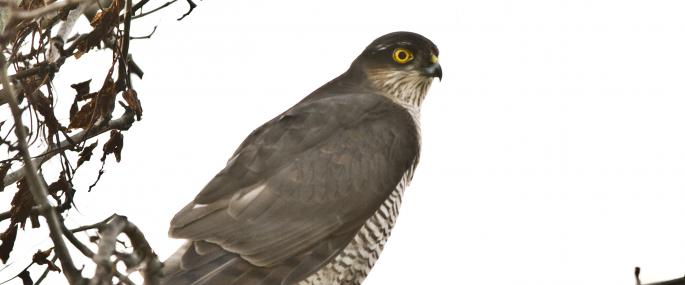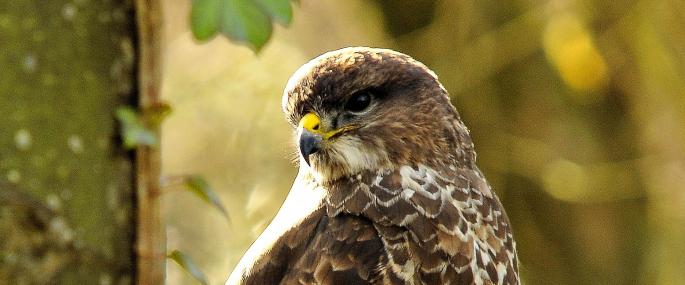Hobby
The Hobby is a small falcon, smaller than a Kestrel. With their long wings and streamlined shape, they are perfectly evolved for catching dragonflies and small birds, such as House Martins and Swifts, on the wing, often transferring their quarry from talon to mouth in mid-air. They are a migratory species, coming to Britain in summer to breed and wintering in Africa. Hobbies can be seen hunting over heathlands, flooded gravel pits and woodland edges.
The loss of our wetland and heathland habitats to development, drainage and agricultural improvements, is a threat for many of our bird species, such as the Hobby. The Wildlife Trusts manage many wetland and heathland nature reserves for the benefit of the wildlife they support. You can help by supporting your local Trust and becoming a member; you'll find out about exciting wildlife happenings, events on your doorstep and volunteering opportunities, and be helping local wildlife along the way.

Kestrel
Kestrels are one of our best known bird of prey; a familiar sight hovering over the side of the road, on the lookout for small mammals like field voles which are their favourite food. Kestrels are a little smaller than a pigeon and can be found in all kinds of habitats from open countryside to towns and villages. They nest in holes in trees, old buildings and abandoned crows nests, laying between four and five eggs, which both parents will feed when hatched.
During the past 40 years kestrel numbers have declined by 25% in the UK, probably as a result of the intensification of agriculture reducing the availability of their small mammal prey. The Wildlife Trusts are working closely with farmers and landowners to promote wildlife-friendly practices. We are working towards a 'Living Landscape': a network of habitats and wildlife corridors across town and country which are good for both wildlife and people. You can support this greener vision for the future by joining your local Wildlife Trust.

Sparrowhawk
Sparrowhawks are one of our smallest birds of prey, the male being somewhere between a blackbird and a collared dove in size. The female is larger, up to the size of a pigeon. Sparrowhawks are excellent bird-hunters, catching small species like finches, sparrows and tits using a mixture of methods that include ambushing prey from a perch or flying low and suddenly changing direction.
To find out more about encouraging wildlife into your garden, visit our Wild About Gardens website: a joint initiative with the RHS, there's plenty of facts and tips to get you started.

Buzzard
Buzzards suffered from persecution and pesticide poisoning in the early 20th century and until recently were only found in the north and west of the country. Over the last couple of decades they have been doing very well and can now be found almost everywhere in the UK. Listen out for their cat-like, 'kee-yaaa' calls as they soar in high circles over grassland, farmland and woodlands. Buzzards eat small birds, mammals and carrion, but will also eat large insects and earthworms when prey is in short supply.
Like many of our birds of prey, the buzzard was severely persecuted in the UK. This species also suffered declines in the 1950s when rabbit populations crashed due to myxomatosis infections. Thankfully, buzzards are a success story - increasing in number and now widespread across the country. To ensure their continued success, The Wildlife Trusts work closely with farmers and landowners to promote wildlife-friendly practices. We are working towards a 'Living Landscape': a network of habitats and wildlife corridors across town and country which are good for both wildlife and people. You can support this greener vision for the future by joining your local Wildlife Trust.

Hen Harrier
Hen harriers nest on the ground amongst heather on upland moorlands and winter in the lowlands, particularly around the coast, on heathland and on farmland. They are currently the most endangered breeding bird of prey in England: hen harriers feed on small grouse and fowl (hence their name) which brings them into conflict with gamekeepers and farmers.
Hen harriers are one of our most persecuted birds, shot and poisoned for taking game species. Coupled with widespread damage to their wetland and heathland habitats, they have suffered massive declines. Various initiatives are now in place to help this beautiful bird to survive. The Wildlife Trusts are working closely with farmers and landowners towards a 'Living Landscape': a network of habitats and wildlife corridors across town and country which are good for both wildlife and people. You can support this greener vision for the future by joining your local Wildlife Trust.

Marsh Harrier
Marsh harriers were severely persecuted in the past for taking game species. Coupled with widespread damage to their wetland habitats, they suffered massive declines in the 18th and 19th centuries. Thankfully, numbers of this beautiful species are beginning to increase gain. To ensure they have continued success, The Wildlife Trusts work closely with farmers and landowners to promote wildlife-friendly practices. We are working towards a 'Living Landscape': a network of habitats and wildlife corridors across town and country which are good for both wildlife and people. You can support this greener vision for the future by joining your local Wildlife Trust.

Osprey
The Osprey is no stranger to fame and attention - its pursuits have been followed closely by nestcams
Ospreys were severely persecuted across Europe in the past, but thankfully are beginning to increase in number today. To ensure they have continued success, The Wildlife Trusts work closely with farmers and landowners to promote wildlife-friendly practices. We are working towards a 'Living Landscrape': a network of habitats and wildlife corridors across town and country, which are good for both wildlife and people. You can support this greener vision for the future by joining your local Wildlife Trust.

Red Kite
Red Kites were severely persecuted in the past but, thanks to a successful reintroduction programme, are beginning to bounce back today. To ensure they have continued success, The Wildlife Trusts work closely with farmers and landowners to promote wildlife-friendly practices. We are working towards a 'Living Landscape': a network of habitats and wildlife corridors across town and country which are good for both wildlife and people. You can support this greener vision for the future by joining your local Wildlife Trust.

Golden Eagle
The golden eagle is the top predator in the Scottish countryside; it is a massive bird of prey that mainly hunts rabbits and mountain hares but will also catch foxes, young deer and large birds like grouse. It can be seen soaring high in the sky in upland areas and remote glens in the north and west of Scotland. Golden eagles have large home territories, nesting on rocky cliff faces and in trees where it builds a giant nest or 'eyrie'. These nests are often used by successive generations to rear their own young. Golden eagles pair for life.
Golden eagles have been severely persecuted in the past, still suffering today from illegal poisoning, egg-collecting and habitat loss. The Wildlife Trusts work closely with farmers and landowners to promote wildlife-friendly practices. We are working towards a 'Living Landscape': a network of habitats and wildlife corridors across town and country which are good for both wildlife and people. You can support this greener vision for the future by joining your local Wildlife Trust.

White-tailed Eagle
Our largest bird of prey, the white-tailed eagle, sometimes known as the 'sea eagle', was persecuted to extinction in the UK; in 1916 the last female was shot on the Isle of Skye. It was reintroduced during the 1970s from Norway and around 40 pairs now nest in Scotland thanks to huge conservation efforts. Good places to spot the white-tailed eagle include the Isle of Mull, off the west coast of Scotland where it hunts for fish, mammals and small birds.
White-tailed eagles were persecuted to extinction, only surviving in the UK thanks to a successful reintroduction programme. These birds are still threatened, however, as our wetland and coastal habitats continue to degrade and pollutants build up in the food chain, affecting these and other apex predators. The Wildlife Trusts work closely with fishermen, farmers, landowners and developers to ensure that our rare wildlife is protected. You can help this vital work by supporting your local Wildlife Trust.
